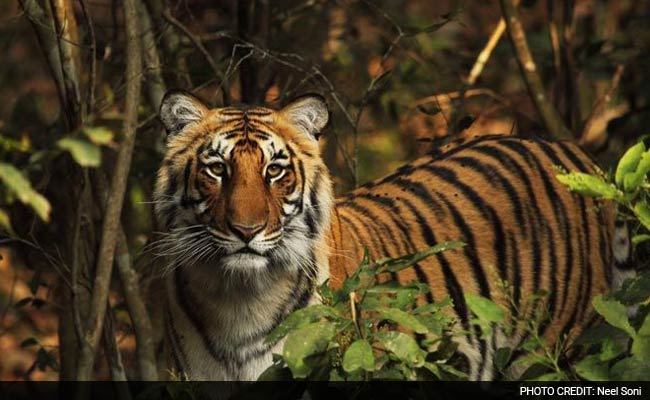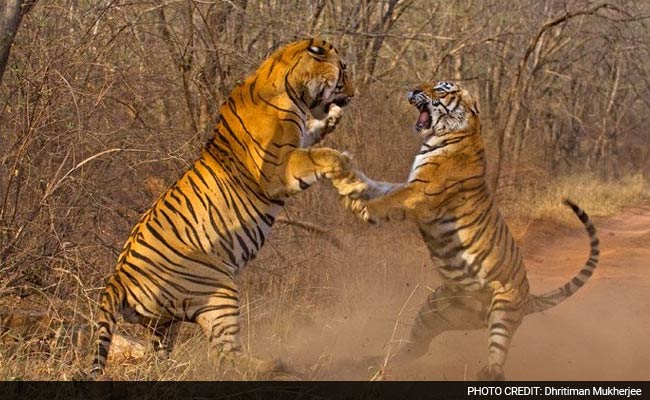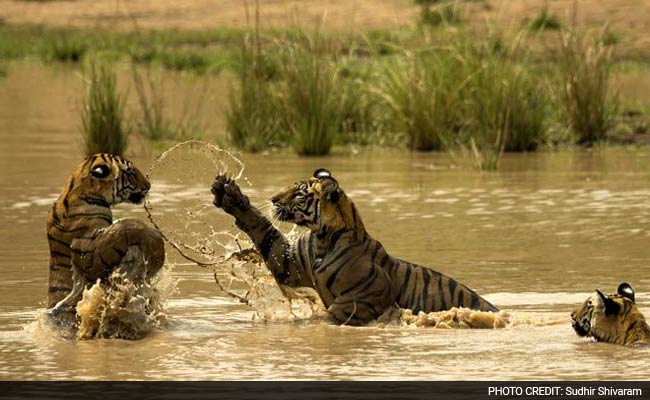This happened just on the fringes of the buffer zone near the Bandhavgarh tiger reserve in Madhya Pradesh a few days ago.
Of course it's nerve wracking to have the world largest feline predator sitting at the edge of one's field. The more sensible course of action would have been to call the Forest Department and get them to move the animal. Sure, the best course of action would have been to wait it out, stay far away and hope the tiger moves on soon, but the men probably had to work the field, as it's their only livelihood.

This particular tiger, according to the Forest Department, has been in the area for the past few days and has killed three cattle. He is not aiming to kill a person at all. But the potential for conflict is very high. More cattle kills, and irate villagers might decide to take matters into their own hands and poison him; or, in the process of a cattle kill, the tiger could accidentally kill a person, setting the tiger and people on a bad path.
On Global Tiger Day, we are celebrating the increase in tiger numbers. We are feeling pleased that India today is home to almost 70% of the world's tiger population. There are 2,226 tigers in India, but these numbers have to compete with other numbers that usually take precedence. 1.2 billion people. India is home to almost 18% of the world's human population. Just from 2001 to 2011, we added more people to our population than the entire population of Brazil. Our population density is at 400 people per sq km. These are staggering numbers.

It's a miracle we are still a country of mega diversity, that we still have three of the world's big cats roaming our landscapes: the tiger, lion and leopard. We still have mega fauna like rhinos, gaurs, wild buffalo and elephants. But we are in conflict with all of them. Because while our mega diversity is still due to the fact that people for the most part in India are tolerant and accepting of the wild, our development drive is ruining habitats for these animals, forcing them closer to people.
This forced closeness is also eroding a long habit of cultural tolerance.
Most of the development that is responsible for ruining our wild landscapes and threatening species is development that helps those of us living in urban areas. It's our demand for power, roads, steel, iron, water and consumer goods that is endangering our wild heritage. The people living in the fringes of forests do not benefit from this development, and yet they pay the highest price. The animals too pay a steep price by being forced into confrontational situations and being killed and hounded for it.

Right now, just 5% of India is protected forests, either as national parks or as animal sanctuaries. Of this, tiger landscapes are less than half. The tigers need space and they need safe passage in which to move and thrive. If we are serious about saving tigers, then we cannot do it without saving the people who live with these animals on their doorstep.
For you and me in the city, we are tourists in the tiger's landscapes, we can always leave. The farmer who was mauled is a neighbour and has nowhere to go.
Creating safe spaces for tigers, which means protecting habitats outside sanctuaries and national parks while helping local communities benefit from the presence of wildlife rather than losing out, is the most crucial step in securing the future of tigers in the country.
(Swati Thiyagarajan is a senior special correspondent with NDTV.)
Disclaimer: The opinions expressed within this article are the personal opinions of the author. The facts and opinions appearing in the article do not reflect the views of NDTV and NDTV does not assume any responsibility or liability for the same.


